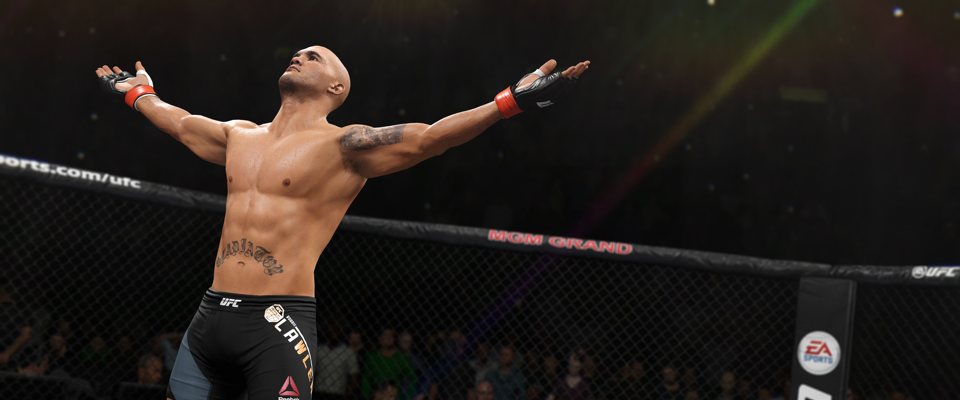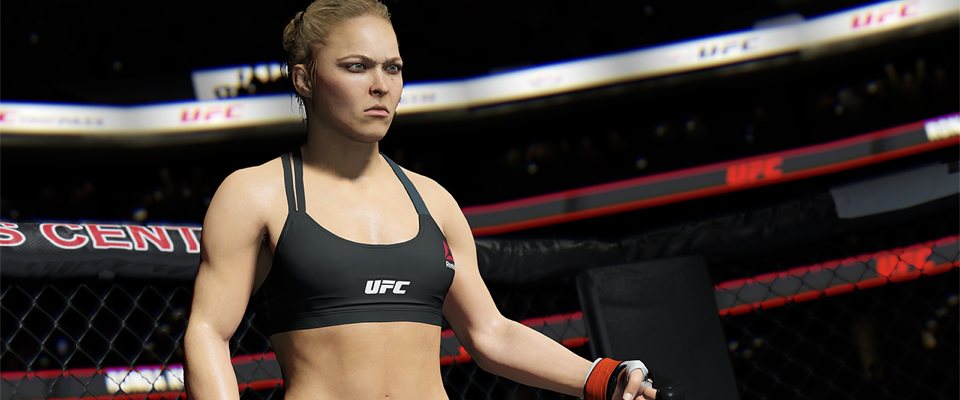The Ultimate Fighting Championship is probably enjoying its highest peak of popularity peak to date. Even the most casual sport fan has probably heard of Ronda Rousey and Conor McGregor, and even more so after each suffered high profile losses recently. The arrival of EA Sports UFC 2 latches perfectly onto this upswing in popularity, with a marked improvement over EA Sports UFC and a couple of lessons learned from THQ’s UFC Undisputed series.
When UFC 2 first starts, you’ll watch a championship fight play out before control is handed to you in the fifth round. The fight acts as a basic tutorial on how to throw punches and kicks, as well as defend yourself. Here you’ll also learn just how brutal the sport can be.
The basics figured out, it’s best to head onto the career mode so you can get to grips with how UFC 2 works, and learn the more advanced moves. Here you’ll create a custom fighter and decide everything from how they look to which weight they’ll fight in – women are limited to bantamweight. Then you choose the fighter style with the options being Tae Kwon Do, Boxer, Freestyle Wrestler, Greco-Roman, Jiu Jitsu, Muay Thai, Judo, Karate, Kickboxer, or Mixed Martial Artist.
Personally I chose Taw Kwon Do since it is a sport I have a background in, so felt comfortable with the style. This choice determines how the attribute points are spread, with a Tae Kwon Do fighter having a strong stand up compared to a freestyle wrestler who is better in the clinch and taking the fight to the ground.
The career kicks off with you taking part in The Ultimate Fighter, a rendition of the real world reality TV series where fighters from around the world train and compete with each other to earn a UFC contract. Two big UFC names coach a team each season, with members of those teams facing off against. The winner of the fight advances while the loser is knocked out of the competition. Should you get past this stage, you’ll begin near the bottom of the rankings for your selected weight class.
The majority of the time you can pick your opponent, but you won’t always get a choice is a more established name appears on your radar. You will then get to take part in a training camp to prepare for the fight. Training consists of completing what are essentially mini games designed to improve your own skills, be they learning to defend against submissions or placing strikes. The higher the score the better the attribute increase.
In EA’s first UFC game, the career mode got stale very quickly, but situations arise to keep you on your toes in UFC 2. For example, the gym could be closed for the week due to renovations meaning you only have two training slots instead of three. You’ll also need to watch out for injury during training, as these have an adverse affect on your fighter’s attributes and can tie into your career longevity.
All fighters have a limited career time and in UFC 2 that is determined by the amount of fans you have and the condition of your body. The more fans the longer your career should last, but you’re always fighting against the wear and tear your body takes as you age, which can shorten your fighter’s life in the Octagon.
The biggest addition to UFC 2 is Ultimate Team, a feature I was sceptical of when first announced. The name naturally brings to mind the Ultimate Team mode from FIFA, but this also has a lot in common with Be A Pro. You can create a team of up to five fighters using the weight classes of middleweight, heavyweight, lightweight and women’s bantamweight. The rest of the creation options are the same as the career mode.
When it comes to card packs, instead of adding fighters to your team you’ll earn perks, training cards, attribute boosters, move cards and fitness cards. Each of these cards is ranked from basic to master, with the latter being harder to get but very rewarding when you do have them. Training and fitness cards are one time use only, with the former being able to boost health or toughness while the latter helps you recover from a fight. You’ll want to hope for various move cards so you can increase your fighter’s arsenal in various areas.
You can buy new card packs from the store with either in game currency or with real money. You can also earn bonuses from the Live Event mode, where you predict the results of upcoming UFC events. If you can guess the winner, when and how the fight ends then you’ll get a little extra.
The premium packs have cards that can applied to any fighter, as well as style specific packs too. Unfortunately, though you can sell unwanted cards for set prices, there isn’t a marketplace where you can put cards up for auction and purchase others. Of course, the cards and setting up your team is all a prelude to competing in single player competitions or against other players to gain titles and climb the divisions.
When it comes to the gameplay there is a marked improvement over EA UFC, especially when it comes to knockouts. In the previous game there were set animations for knockouts, but that has been overhauled thanks to the Knockout Physics System. Now fighters will fall almost like they would in reality when suffering a knockout.
Blocking has also had changes applied, with a one button system replaced with two buttons. The right shoulder button blocks incoming headshots, while the right trigger is for blocking lower shots. This does take some getting used to and you need to learn to read your opponents much better as a result.
There’s a lot of other changes and tweaks to the fighting as well. Arms now take damage separately to the body, while TKOs return for the first time since UFC Undisputed 3. Although the ground control has also been polished and there seem to be more transitions between starting a move and reaching a tap out stage for a submission, but this is one area that could still be bettered.
Fighters move smoothly enough during the action and react accordingly to the damage they take. Too much leg damage will see them limp a bit, while constant shots to the body will tire a fighter out so they’re out of breath by the end of the round. When a fighter gets rocked, it does seem slightly tougher to get the knock down outright, but even if a fighter does fall there is a small window of recovery before a fight is declared over. All you need is one well placed punch or kick to turn the tide and stun someone who had the upper hand.
Knockout Mode has been added to UFC 2 and here players can compete against each other locally to knock their opponent out. In a standard round five significant strikes is all it takes to win a round, with the winner crowned by getting best two out of three. Of course there are options to change it. While knockout mode is fun it’s just a diversion from what is on offer elsewhere. However, it does highlight that the main portion of the game isn’t readily accessible for newer entrants to the series, which is something EA should look to address for UFC 3.
What’s Good:
- Knockout Physics System adds a sense of realism.
- Large roster of fighters.
- Ultimate Team very well crafted.
- Career mode vastly improved over predecessor.
What’s Bad:
- Not that accessible to newer players.
- No auctions in Ultimate Team.
As someone who has played almost every MMA game since UFC Undisputed 2009, many of the controls came naturally to me, but UFC 2 features quite the learning curve if you’ve never played a UFC game before. Whether it’s Ultimate Team, knockout physics or improved grappling, EA have made great strides to improve and make UFC 2 the best MMA game on the market so far. That isn’t to say there isn’t still room for improvement but there is a lot of fun to be had here.
Score: 9/10
Version tested: PS4



blast71
I’m a big fan of mma but not of fighting games. Saying that, I might check this out when it’s cheap.
Jim Hargreaves
Been playing this with housemates and it’s immensely fun so far. Good to see they’ve done away with the confusing clinch/grapple system.